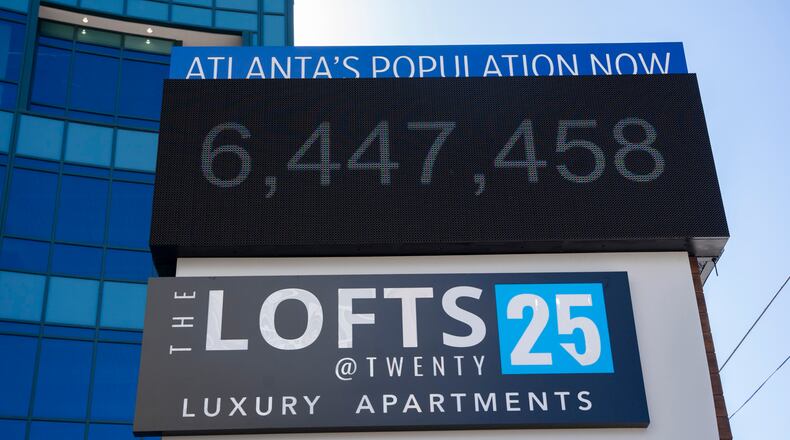Diversity is one of Atlanta’s strengths, and that’s expected to only increase in the decades to come.
The Atlanta Regional Commission forecasts that the 21-county metro area will add 1.8 million people by 2050, bringing the capital of the Southeast to 7.9 million residents. The regional planning agency expects the growth will be driven by the region’s career opportunities and desirability among other major cities, especially among people of color.
“Almost all of the growth that we’re going to be getting over the next 30 years is going to be coming from populations of color,” said Mike Carnathan, the ARC’s managing director of research and analytics.
Hispanics and Latinos are predicted to lead that charge, nearly doubling their share of metro Atlanta’s population. Those groups currently make up 12% of the region’s population, but they’re expected to grow to 21% by 2050.
Asians and other minority groups are also expected to make sizable gains during that time frame, while white and Black residents will make up a smaller proportion of metro Atlanta than they do today. Not only will Atlanta become more diverse, it’ll grow older with more people living past the age of 75 due to modern medicine and health care access.
The ARC’s predictions center around recent demographic trends and anticipated growth to fill 856,000 additional jobs expected to come to metro Atlanta by 2050. ARC analysts predict transplants and new graduates will fill the bulk of those new jobs.
Atlanta, often heralded as “The city too busy to hate,” is hailed by business leaders for its home-grown diversity, something employers can struggle to find among talent pools elsewhere. The expectation that metro Atlanta will further diversity — with Hispanics, Latinos and Asians also spreading out in greater numbers in the suburbs — only serves to further Atlanta’s reputation as a beacon of diversity, experts say.
“What makes Atlanta so appealing? Its talent,” Southern Company President and CEO Chris Womack told The Atlanta Journal-Constitution in November. “How do we continue to make Atlanta appealing? More diverse talent.”
The ARC population estimates are more than just an attempt to peer into the future; they help inform elected officials on how to plan for that future.
Government leaders use these long-term projections as a roadmap for how to prepare for this potential influx of new residents, informing policy decisions on transportation, infrastructure, housing and zoning. The ARC estimates that $168 billion of infrastructure projects are needed across metro Atlanta to facilitate the expected growth. The people who make up the metro Atlanta of tomorrow are also critical since specific communities have different needs.
“If you look at the composition of the people today, it looks a lot different than it did in 1990 or 1980,” Carnathan said. “And it’s going to look a lot different in 2050 than it does today.”
Importance of birth rates
There are only two ways for a population to grow: migration and procreation.
The number of people moving to cities and countries has dipped because of the COVID-19 pandemic, but Atlanta and other Southeastern cities have seen a steady supply of transplants with no signs of reversing. Carnathan said there’s a lack of demographic data on why specific groups move to metro Atlanta rather than other places.
But birth rates have clear patterns.
Decades ago, white Georgians became the first group to see fertility rates dip below replacement, meaning average birth rates dropped below two children. Asians dropped below that line in the early 1990s, while Blacks followed suit before 2010. Hispanics and Latinos were the last to see their birth rates drop, which is why they are expected to make up much of the region’s forthcoming population boom.
Gwinnett County is currently home to the largest proportion of Hispanic and Latino residents with more than 200,000. By 2050, Cobb and DeKalb counties are expected to meet that mark, with five other counties in Atlanta’s core and suburbs surpassing 50,000 Hispanic and Latino residents.
Santiago Marquez, CEO of the Latin American Association, said the projections have prompted his organization to launch its first comprehensive growth campaign in decades, because more counties will need robust Latino-focused services.
Credit: Joann Vitelli
Credit: Joann Vitelli
The Buford Highway corridor, which cuts through DeKalb and Gwinnett, has been the long-time hub for the metro’s immigrant communities, including many first-generation Hispanics and Latinos. The Latin American Association’s primary office in Brookhaven has served those communities for decades, offering workforce training, housing assistance, immigration services and education. But Marquez said other communities will need to replicate those services if ARC’s projections become reality.
“In those counties, there tends to be very little, if any, services that are being provided for the Latino community,” he said. “That’s really shaping our strategy going forward.”
About the Author
Keep Reading
The Latest
Featured




